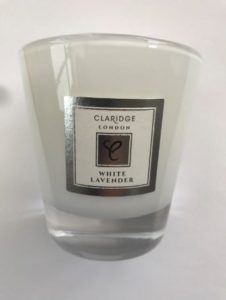Claridge’s succeeds in trade mark dispute – but was it worth the candle?
02.08.2019
The world-famous Claridge’s hotel has succeeded in a trade mark infringement and passing off claim against Claridge Candles.
However, in the process of successfully enforcing its trade mark rights against a small one-woman business from Kent, the hotel’s has been forced to surrender one of its trade mark registrations entirely and also seen the specification of another of its trade mark registrations pared back significantly following a non-use counter-claim.
Background and summary
On 29 July 2019, Recorder Douglas Campbell QC handed down judgment in Claridge’s Hotel Limited v Claridge Candles Limited & Denise Shepherd [2019] EWHC 2003 (IPEC).
The claimant (“Claridge’s”) has operated a well-known hotel in London under the name CLARIDGE’S since its incorporation in 1889. Its logo and trade mark registration is shown below. The first defendant (“Claridge Candles”) has sold CLARIDGE branded candles and reed diffusers since September 2018. An image of the CLARIDGE candle is also shown below:
| Claridge Candles | Claridge’s logo | Claridge’s trade mark registration |
 |
CLARIDGE’S |
The second defendant is the sole owner and director of Claridge Candles. The defendants’ candles were said to be named after the first line of the second defendant’s address (Claridge Court), and the second defendant’s unchallenged evidence was that she did not even think of the hotel when the name was chosen.
Claridge’s brought a claim against Claridge Candles for trade mark infringement and passing off in the IPEC. Claridge Candles counterclaimed for partial revocation of Claridge’s registered trade marks on the basis of non-use.
Claridge’s succeeded in its claims for trade mark infringement (under s.10(3), but not s.10(2)) and for passing off. However, Claridge Candles’ counterclaim for revocation was also partially successful, and so the specifications of Claridge’s trade marks have been pared back.
The trade marks relied upon
Claridge’s initially relied on two registered UK trade marks. However, it voluntarily surrendered one of these marks as a result of the defendants’ non-use counterclaim. Claridge’s also partially surrendered part of its second trade mark.
The sole trade mark relied upon by Claridge’s at trial was UK2397526 for the word CLARIDGE’S which was registered in Classes 3, 5, 16, 35, 43 and 44 (the “‘526 mark”). The ‘526 mark covered, amongst other things: toiletries, bath preparations, printed publications, retail services connected with the same of food, hotel, restaurant and café bar services, and the provision of beauty treatments.
Successful counterclaim for non-use
Claridge Candles counterclaimed to revoke the ‘526 mark on the basis that it was over five years old and had not been used across the full breadth of its specification.
Mr Douglas Campbell therefore reviewed the evidence of use which Claridge’s put forward to establish genuine use of its trade mark. Claridge’s evidence and arguments were focused on its use of goods in Classes 3 and 5, given that these were considered to be the closest to the goods offered by the defendants (candles and reed diffusers). Whilst Claridge’s could demonstrate that it had provided its hotel guests with thousands of bottles of Claridge’s branded shampoo and conditioner, the judge held that this was not genuine use of the Claridge’s trade mark because the use was not done to create or maintain a market for toiletries – the goods were never marketed separately, they were simply included to guests as part of their stay in the hotel. The defendants’ counterclaim therefore succeeded in respect of all of the goods in Classes 3 and 5 of the ‘526 mark.
Claridge Candles was also partially successful in its counterclaim in respect of the goods and services in Classes 16, 35, 43 and 44. The ‘526 mark was therefore pared back in accordance with the Court’s findings.
Trade mark infringement
In light of the Court’s findings in the counterclaim, the claim for infringement pursuant to s.10(2) fell away – this was because all of the parts of the specification which were relied on for the infringement claim were revoked for non-use.
The infringement claim therefore focused on s.10(3). The Court found that the mark CLARIDGE’S had a “very substantial reputation when used in relation to hotel services”, and that it has an image of “luxury, glamour, elegance and exclusivity”. The threshold for bringing a claim under s.10(3) was therefore easily met.
The Court then reviewed the criteria for infringement under s.10(3) as set out in Comic Enterprises v 20th Century Fox, focusing on the issues of whether (i) the Defendants’ use gives rise to a link between the defendants’ sign and the claimant’s trade mark; and (ii) the defendant’s use gives rise to one of the three types of injury (dilution, tarnishment, or unfair advantage).
Mr Douglas Campbell QC was satisfied that consumers would link the defendant’s goods to the claimant’s trade mark given the similarity of the brand names, the fact both are sold as luxury offerings, and the high strength of the Claridge’s trade mark. In his analysis of whether or not there was a ‘link’, the judge also found the existence of a likelihood of confusion – this is a rather unusual finding to be made in a case where the s.10(2) case failed. In any event, the Court went on to find that the defendant’s use of CLARIDGE took unfair advantage of the hotel’s reputation for luxury and glamour, and that the use of the sign enabled the defendants to charge higher prices and/or sell more of their candles. The infringement claim under s.10(3) therefore succeeded.
Passing off
Unusually, the claimant submitted that its passing off case stood or fell with its case on 10(3).
The Court was persuaded that the use of CLARIDGE on the defendants’ candles was likely to lead the public to believe that the goods were connected in the course of trade with CLARIDGE’S. This is in line with the finding, mentioned above in relation to the 10(3) claim, that there was a likelihood of confusion arising between the parties’ goods.
Having also been satisfied that damage would arise, the passing off claim against CLARIDGE CANDLES succeeded.
Comment
In many ways, the outcome of this case is of little surprise – despite the differences between the goods and services offered by the parties, s.10(3) exists precisely for cases such as this – where a trade mark owner such as Claridge’s, with its long history and extensive reputation, finds that its brand is being used on dissimilar goods in a way which takes unfair advantage of that reputation.
However, the case is also a useful reminder to parties that their trade mark registrations are very likely to be attacked as soon as they are asserted in infringement proceedings, and that they will be revoked or partially revoked if they are more than five years old and evidence cannot be adduced to show that they have been put to genuine use across the full breadth of their specification. Claimants should bear this in mind before commencing proceedings – and if the claimant has an armoury of trade marks to select from then particular care should be taken to select the best registration for the purposes of any claim.

Sean Ibbetson
Author
